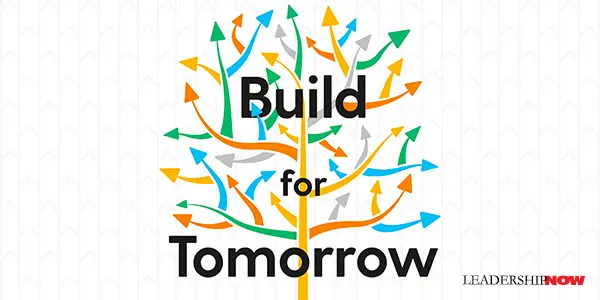 |
 |
09.07.22

Build for Tomorrow
CHANGE is frequently a challenge, but in times of wide-ranging, disrupting, unavoidable change, it can be disquieting. Jason Feifer, the editor-in-chief of Entrepreneur magazine, has written a book for anyone facing an uncertain future, not just entrepreneurs. That’s most of us. Build for Tomorrow is about how we can be good at change—especially change that happens to us—sometimes more like a crisis. When faced with change, Feifer has found that we experience four phases when we are faced with change we didn’t initiate. The question is, how fast will we move from Panic! to Wouldn’t Go Back? Build for Tomorrow is designed to help us do just that. 1. Panic! Panic is natural, but staying in this stage blinds us. In this state of mind, we can’t accurately see what we are faced with. “We become impatient for solutions, do not consider all the information available, and make counterproductive decisions.” A couple of the reasons we get stuck in Panic mode is because loss is easier to see and feel than gain. We naturally extrapolate loss, so we must counter it by extrapolating the gain. We also believe that yesterday was better than today.”If we’re surrounded by the belief that yesterday was better, we’ll become less open-minded to future opportunities.” Sometimes we feel like we got where we are by sheer luck—the right place at the right time. But if we can get some perspective by asking ourselves three questions—What did I overcome? What skill set did I have then that I still have now? And what do I know now that I didn’t know then?—we can build on where we are and move forward. 2. Adaptation When confronted with change, it is easy to tell ourselves that “something is happening to me.” But that is not a productive thought because it makes us the victim. We feel out of control and acted upon. We reason that “change is scary because it seems all-encompassing and permanent,” and it will change us in all-encompassing and permanent ways, and as a result, we lose our identity—who are we anyway? But Feifer says, “We are not what we do. We are why we do it.” We need to get to the why. To adapt to the change we face, we need to widen our bands. Get out of our heads. We tend to think that everyone is thinking like us. They aren’t. Look beyond the moment. Build for tomorrow. The time to change is not “at the moment of pain—it’s at the moment of awareness.” Feifer makes the interesting point: work your next job. If we focus only on what we are doing now, we will only be qualified to do what we are doing now. But if we focus on what we could do and learn what we must, then we set ourselves up for tomorrow and the inevitable change that is coming. “Goals can be motivating but limiting. It is a direction but not a map, and it cannot define your whole journey. If you look ahead too narrowly, you’ll miss all of the promising off-ramps in your periphery.” 3. New Normal The new normal is another temporary state on our journey through life. If we are to embrace a change, we need to “identify parts of our old experience that do not change, and then use them to reframe the new opportunity in front of us.” Some things never change, and they play a part in what is changing. “You acclimate to a New Normal by seeing things as they are instead of how they were.” Try asking, “What is this for?” Instead of trying to stop or control the impending change, asking what”-is-this-for” opens us up to opportunities and gives us a new purpose and way of showing up in the world. It is a question we should constantly ask about everything we do like, what is your time for? Or What is small talk for? (“Small talk is a way to establish mutually that you’re both people who are capable of interacting.”) 4. Wouldn’t Go Back What we once thought was impossible is now the real opportunity, and we wouldn’t go back. “True opportunity exists in the unknown.” To reach our Wouldn’t Go Back moment we must reconsider the impossible. That is to say, we take another look at the things we once discarded—the things we thought were impossible, illogical, too difficult, too radical, too ridiculous to even consider—and explore whether they were the real opportunity all along. If you’re looking for a competitive advantage, ask yourself, “But Really.” On the surface, we think we know, but really there is something else going on. Only by asking but really, can we drill down to what is the fundamental difference. In your personal life, “I may be dissatisfied with my job, but really I’m being pushed to better identify what I love and how to pursue it.” Not all change is good, of course, but change is certain. And when it comes, we need to position ourselves to move through the four stages as quickly as possible. Instead of defining ourselves firmly—I am this, I do that—we must recognize that everything we do, as well as everything we are, is simply the next thing in a long line of next things. Everything is the next thing, part of a continuum of successes and failures are doors opening and closing. 
Posted by Michael McKinney at 12:19 PM
|
BUILD YOUR KNOWLEDGE
 

How to Do Your Start-Up Right STRAIGHT TALK FOR START-UPS 
Grow Your Leadership Skills NEW AND UPCOMING LEADERSHIP BOOKS 
Leadership Minute BITE-SIZE CONCEPTS YOU CAN CHEW ON 
Classic Leadership Books BOOKS TO READ BEFORE YOU LEAD |